There are many iterations of a fabled, island-sized sea monster across various cultures, which were in no doubt inspired by early accounts of animals such as the blue whale (Balaenoptera musculus). Blue whales exist in all major oceans, but precise distributions are patchy and their migratory movements are poorly understood. After the species’ initial description by Robert Sibbald in 1694, five subspecies are recognized to distinguish those in the Northern Hemisphere (B.m.musculus), the Antarctic populations (B.m.intermedia), the pygmy subspecies (B.m.breivcauda), the North Indian/Arabian Sea populations (B.m.indica), and the unnamed Chilean blue whales. The blue whale is the largest living animal on Earth and remains the largest known in Earth’s history. At physical maturity, most blue whales range between 21-27 meters in length and weigh approximately 70-150 metric tons, with females being the larger sex. Antarctic blue whales are the largest, with scientists measuring specimens up to 30 meters and whaling data citing multiple instances of whales reaching 33 meters. The largest ever weighed was 190 metric tons. While there were sauropods that grew longer, they were all much smaller when accounting for overall mass and volume, even when compared to the average blue whale. Recently, the blue whale also became the largest animal in the fossil record, as a 1.37 million-year-old skull of a blue whale that was 23-26 meters long was discovered in 2019. The historical blue whale population is conservatively estimated to have contained 300,000 individuals, with 240,000 in the Antarctic. Intense commercial whaling, especially in the early 1930s, nearly brought the blue whale to extinction. After a slow recovery, the species currently rests at 5,000-15,000 globally, with over 2,000 in the Antarctic. Blue whales primarily feed on krill and other crustaceans such as amphipods, copepods, and mysids. Killer whales are their sole natural predators, but very rarely successfully kill adults.
(12/29/2021)-Updated photos
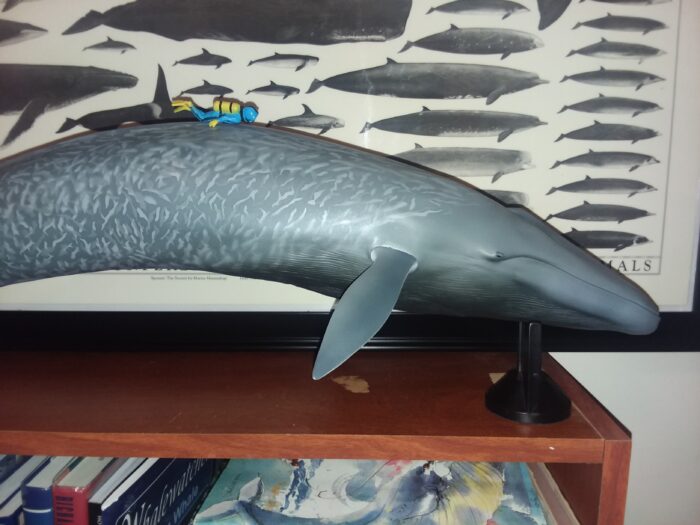
Once again, the blue whale returns to the blog after the Papo figure was reviewed last November. Today’s post is a landmark, as it’s the blog’s first time covering Kaiyodo’s Mega Sofubi Advance line. In the review of the Papo figure, I’ve pointed out the irony of the blue whale’s history in the toy industry. Despite the blue whale being ever-present in size comparison charts of megafauna, the animal toy/model market lacked blue whales that scaled well with many dinosaurs or larger marine life figures, such as from the Monterey Bay Aquarium collection. Now it’s time to see if Kaiyodo’s 2015 release can finally alleviate all of that.
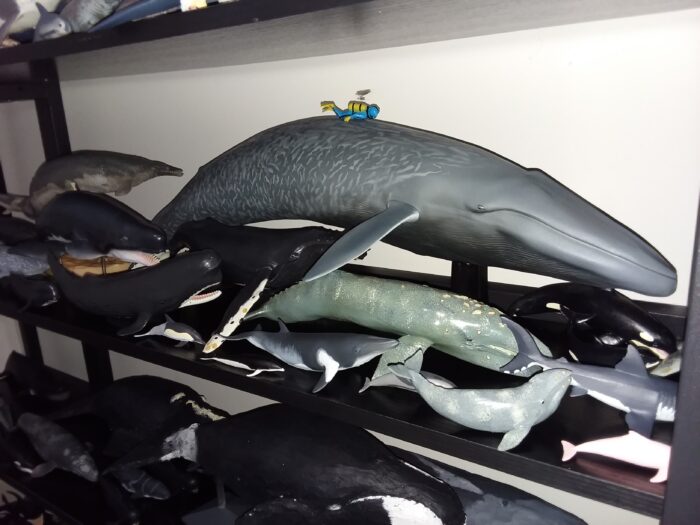
When accounting for the curve, the MSA blue whale is about 78cm long when measured using the scientific standard for whales. The model is anatomically male (I’ll elaborate later), so it generally fits in the 1:26-1:42 scale. This range is calculated from the average length of sexual maturity for a male Chilean blue whale (20.5 meters) to the largest male ever caught (32.64 meters). There’s no two ways about it, this model is rather large. As you can see, it looks perfectly to scale with the MBA humpback whale, CollectA minke whale, and the Safari TOOB scuba diver. When placed at the 1:40 scale with the MBA humpback, it measures 31.2 meters. Such a whale would weigh between 136-202 metric tons depending on the time of year. This model is however, not the largest on the market. That honor goes to PNSO’s blue whale model at 99cm!
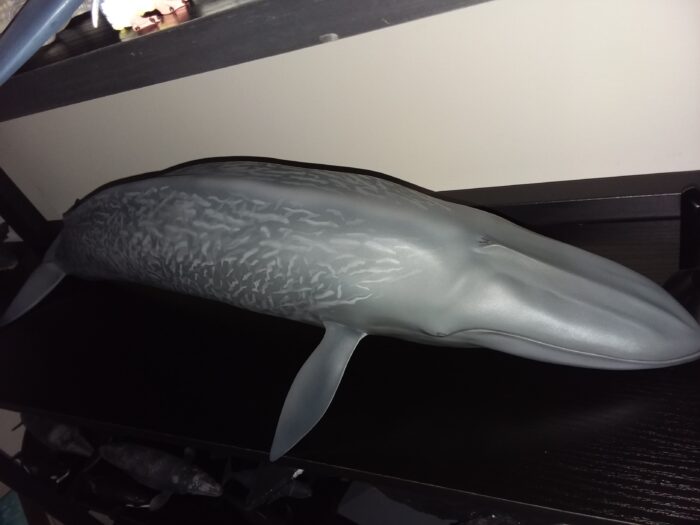
As for the sculpt, I think it’s superb. Getting an accurate-looking model for a blue whale is often taken for granted as even the life-sized museum models had to do a lot of revisions over the years. This was a consequence of dead individuals from whaling catches serving as the primary references for whales in their entirety. Underwater photos were not available until the latter half of the last century. As for the subspecies identity, there’s no clear way to tell as only the pygmy subspecies has been clearly evaluated to show significant differences in anatomical proportions. When disregarding size, this model could adequately represent the Northern, Chilean, or Antarctic subspecies. However, given how the marketed scale is 1:35, this narrows down the model to the Antarctic subspecies, as this is the only subspecies where males have been recorded to achieve 27 meters.
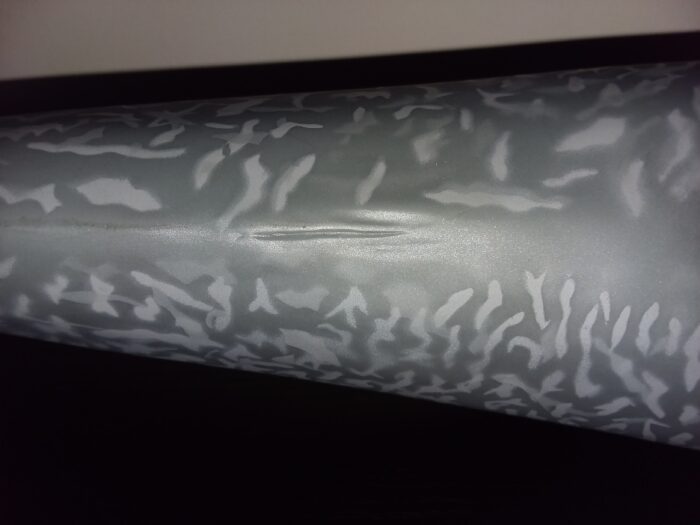
I’ve identified the sex of this model based on the apparent absence of developed mammary slits next to the genital slit. You may notice two depressions next to the genital slit, however, I doubt they’re meant to represent female mammaries. For one, they don’t form full slits when the sculptor could have easily made them so. Furthermore, they’re too misaligned with each other and are positioned too anteriorly relative to the genitalia. It’s more likely that these could be the underdeveloped nipples present in male baleen whales.
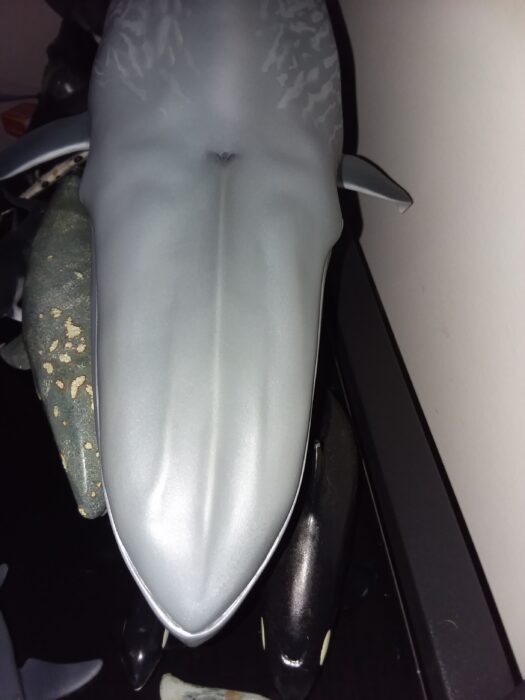
The unique ”U” shape of the snout is well captured and immediately catches the attention of my eye when looking down this model.
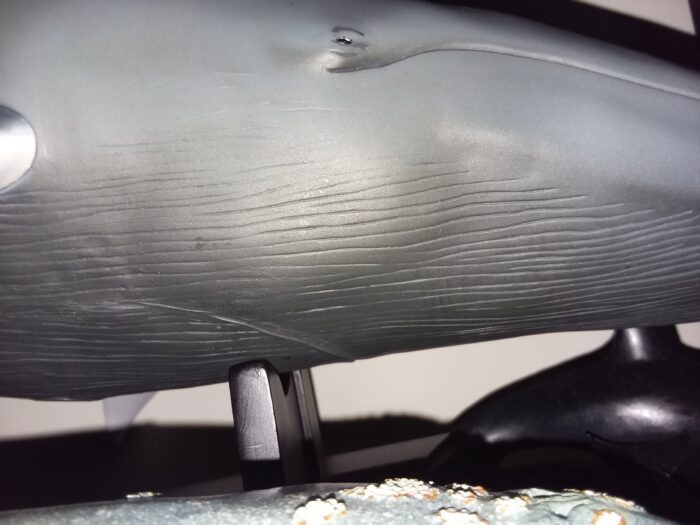
The MSA blue whale gorgeously uses its size to its advantage and applies an anatomically-accurate number of throat pleats. I’ve counted more than 60, which is within the range of 60-88 for the species.
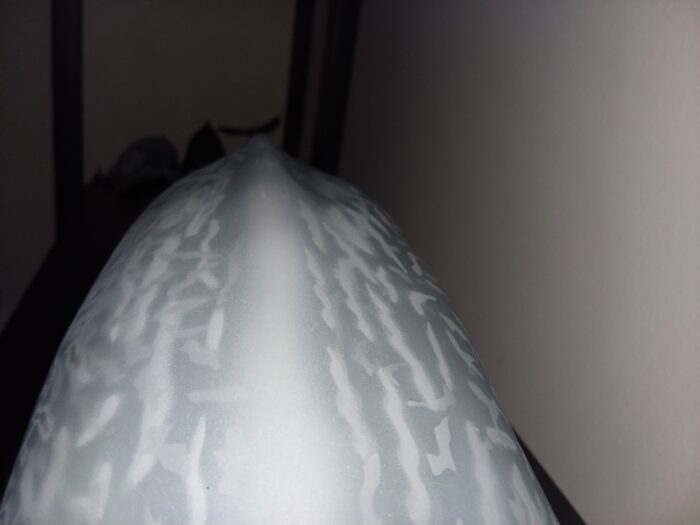
The model displays an odd detail, where the trunk of the whale is not even on both sides, as there’s a depression on the left side of its back . This is part of all of the models, so it’s not any damage on my end. I treat this as a deliberate move to represent ”natural asymmetry” which I’m perfectly okay with.
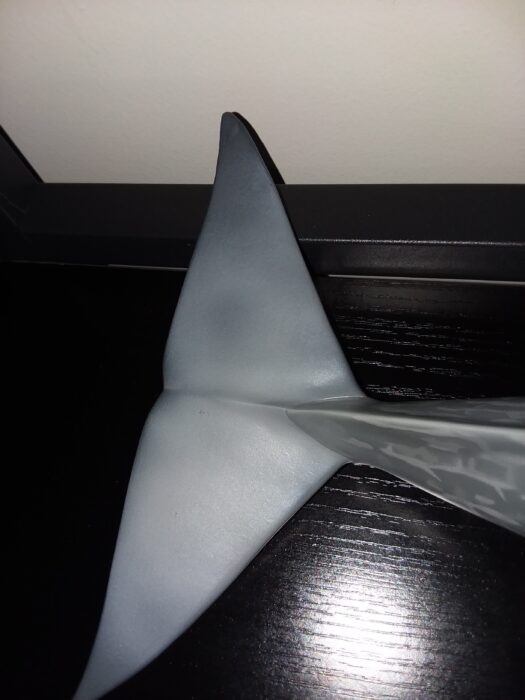
As far as the anatomy is concerned, my only nitpicks are that the lobes of the flukes should have more concave trailing edges and the notch should be deeper.
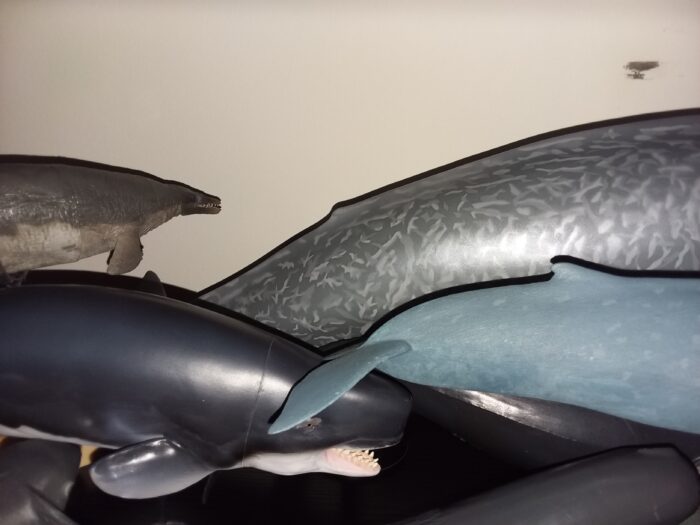
When reviewing the Papo figure, I was not short on praise for its sculpt. I actually don’t think the MSA blue whale completely outclasses Papo’s sculpt in every area. That’s more a compliment to Papo than anything else. I will say the larger size does allow the MSA Blue whale to seem a bit more proportionally correct, specifically regarding the size of the dorsal fin.
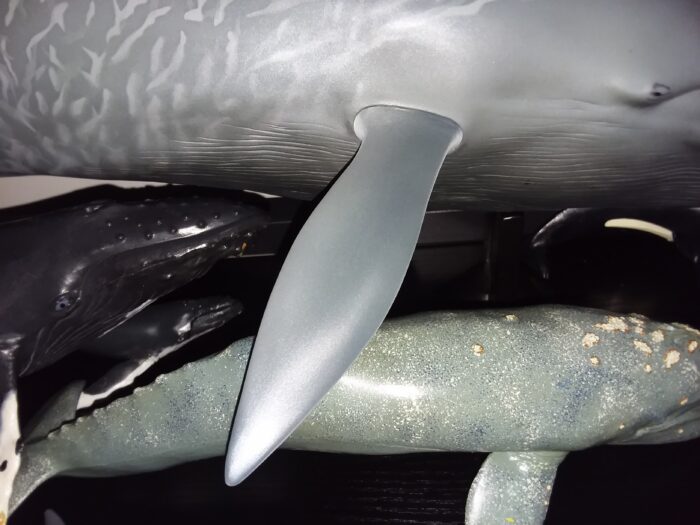
The only aesthetical blemish are the apparent seams around the flippers and flukes. I personally don’t care, as I still think the model looks great regardless, especially when there are so few options.
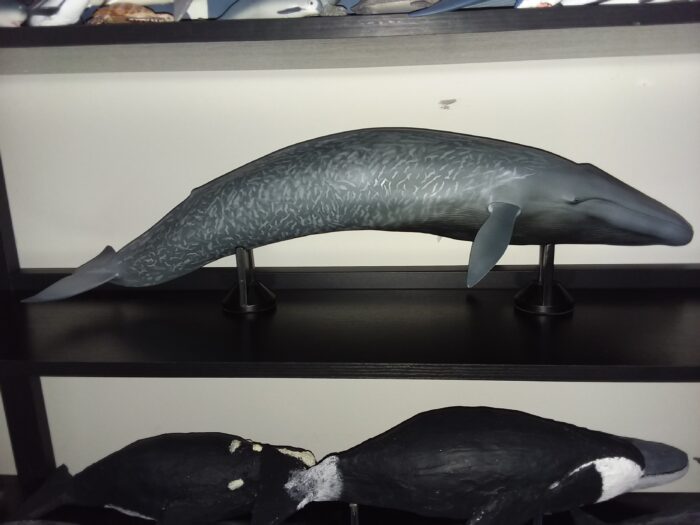
The paintjob itself is also quite perfect. A nice bluish-gray with impressive mottling that ceases at the flukes, flippers and head. The ventral body is also dark gray along where the throat pleats are. The most accurate paintjob I’ve seen in a blue whale model/figure.
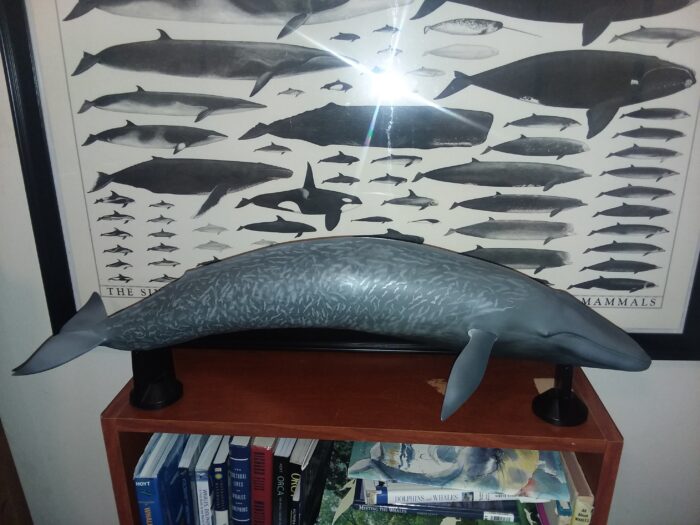
I believe I made my verdict clear regarding on the MSA Blue whale. I think it’s really the best blue whale out there, specifically for the scale-conscious collector. However, I don’t recommend this model to the penny-savers. The MSA blue whale has been discontinued, and while it doesn’t take long to find listings, the model will run you about $300-$400 dollars. Otherwise, my next recommendation would be to purchase the Papo figure and apply a new paintjob.
Disclaimer: links to Ebay and Amazon on the AnimalToyBlog are affiliate links, so we make a small commission if you use them. Thanks for supporting us!




That this is beautiful. Some time ago on the forum the question was asked, what’s your holy grail animal figure? This might be mine.
This one, MBA Humpbackw/ calf, and MBA sperm whale w/calf
That’s one commodious cetacean!